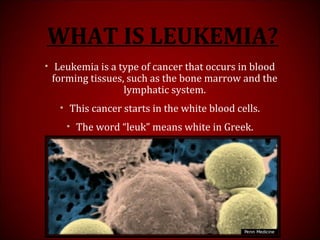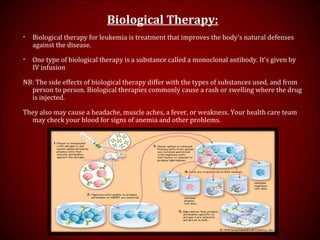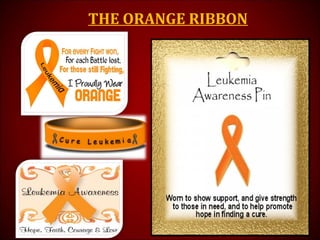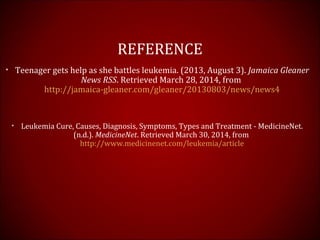Leukemia
- 1. LEUKEMIA
- 2. WHAT IS LEUKEMIA? • Leukemia is a type of cancer that occurs in blood forming tissues, such as the bone marrow and the lymphatic system. • This cancer starts in the white blood cells. • The word “leuk” means white in Greek.
- 3. WHAT CAUSES LEUKEMIA? • Scientists don't understand the exact causes of leukemia. • ABNORMAL CHROMOSOMES • In general, leukemia is thought to occur when some blood cells acquire mutations in their DNA — the instructions inside each cell that guide its action. Or other changes in the cells that have yet to be fully understood could contribute to leukemia.
- 4. HOW DOES ENVIRONMENT AFFECT LEUKEMIA? Research shows that certain risk factors increase the chance that a person will get this disease. Risk Factors are: • Smoking: cigarettes increases the risk of acute myeloid leukemia. • Pollution • petroleum containing products • Benzene: is used widely in the chemical industry. It's also found in cigarette smoke and gasoline • Atomic bomb explosions: Very high levels of radiation have been caused by atomic bomb explosions (such as those in Japan during World War II). People, especially children, who survive atomic bomb explosions are at increased risk of leukemia. • Exposure to radiation and certain chemicals
- 5. OTHER FACTORS • GENETIC FACTOR • CHEMOTHERAPY
- 6. TYPES OF LEUKEMIA Leukemia is either chronic (which usually gets worse slowly) or acute (which usually gets worse quickly): Chronic leukemia: Early in the disease, the leukemia cells can still do some of the work of normal white blood cells. People may not have any symptoms at first. Step 1: Fewer sign Step 2: Spread slowly Acute leukemia: The leukemia cells can't do any of the work of normal white blood cells. The number of leukemia cells increases rapidly. Acute leukemia usually worsens quickly. • Step 1: Fewer sign Step 2: rapidly spread
- 7. CONTINUATION OF TYPES OF LEUKEMIA • leukemia also can be grouped based on the type of white blood cell that is affected. Leukemia can start in lymphoid cells or myeloid cells • There are four common types of leukemia: • Chronic lymphocytic leukemia (CLL): CLL affects lymphoid cells and usually grows slowly. Most often, people diagnosed with the disease are over age 55. It almost never affects children. • Chronic myeloid leukemia (CML): CML affects myeloid cells and usually grows slowly at first. It accounts for nearly 6,000 new cases of leukemia each year. It mainly affects adults. • Acute lymphocytic (lymphoblastic) leukemia (ALL): ALL affects lymphoid cells and grows quickly. ALL is the most common type of leukemia in young children. It also affects adults. • Acute myeloid leukemia (AML): AML affects myeloid cells and grows quickly. It occurs in both adults and children.
- 8. SYMPTOMS OF LEUKEMIA Like all blood cells, leukemia cells travel through the body. The symptoms of leukemia depend on the number of leukemia cells and where these cells collect in the body. People with chronic leukemia may not have symptoms. The doctor may find the disease during a routine blood test. • People with acute leukemia usually go to their doctor because they feel sick. If the brain is affected, they may have headaches, vomiting, confusion, loss of muscle control, or seizures. Leukemia also can affect other parts of the body such as the digestive tract, kidneys, lungs, heart, or testes. Common symptoms of chronic or acute leukemia may include: 1. Swollen lymph nodes (especially lymph nodes in the neck or armpit) 2. Fevers or night sweats 3. Frequent infections 4. Feeling weak or tired 5. Bleeding and bruising easily (bleeding gums, purplish patches in the skin, or tiny red spots under the skin) 6. Swelling or discomfort in the abdomen (from a swollen spleen or liver) 7. Weight loss or loss of appetite for no known reason 8. Pain in the bones or joints 9. Shortness of breath
- 10. PROCEDURES TAKEN TO DIAGNOSE LEUKEMIA Doctors sometimes find leukemia after a routine blood test. If you have symptoms that suggest leukemia, your doctor will try to find out what's causing the problems. Your doctor may ask about your personal and family medical history. You may have one or more of the following tests: • Physical exam: Your doctor checks for swollen lymph nodes, spleen, or liver. • Blood tests: The lab does a complete blood count to check the number of white blood cells, red blood cells, and platelets. Leukemia causes a very high level of white blood cells. It may also cause low levels of platelets and hemoglobin, which is found inside red blood cells. • Biopsy: Your doctor removes tissue to look for cancer cells. A biopsy is the only sure way to know whether leukemia cells are in your bone marrow. Before the sample is taken, local anesthesia is used to numb the area. This helps reduce the pain. Your doctor removes some bone marrow from your hipbone or another large bone. A pathologist uses a microscope to check the tissue for leukemia cells . There are two ways your doctor can obtain bone marrow. Some people will have both procedures during the same visit: – Bone marrow aspiration: The doctor uses a thick, hollow needle to remove samples of bone marrow. – Bone marrow biopsy: The doctor uses a very thick, hollow needle to remove a small piece of bone and bone marrow.
- 11. TREATMENT OF LEUKEMIA People with leukemia have many treatment options. i. watchful waiting ii. chemotherapy iii.targeted therapy iv.biological therapy v. radiation therapy vi.stem cell transplant.
- 12. Watchful Waiting: • People with chronic lymphocytic leukemia who do not have symptoms may be able to put off having cancer treatment. By delaying treatment, they can avoid the side effects of treatment until they have symptoms. • If you and your doctor agree that watchful waiting is a good idea, you'll have regular checkups (such as every 3 months). You can start treatment if symptoms occur. • Although watchful waiting avoids or delays the side effects of cancer treatment, this choice has risks. It may reduce the chance to control leukemia before it gets worse.
- 13. Chemotherapy: • Chemotherapy uses drugs to destroy leukemia cells. Depending on the type of leukemia, you may receive a single drug or a combination of two or more drugs. You may receive chemotherapy in several different ways: • By mouth: Some drugs are pills that you can swallow. • Into a vein (IV): The drug is given through a needle or tube inserted into a vein. • Through a catheter (a thin, flexible tube): The tube is placed in a large vein, often in the upper chest. A tube that stays in place is useful for patients who need many IV treatments. The health care professional injects drugs into the catheter, rather than directly into a vein. This method avoids the need for many injections, which can cause discomfort and injure the veins and skin. – Inject directly into cerebrospinal fluid – Inject straight into spine
- 14. Targeted Therapy: • Targeted therapies use drugs that block the growth of leukemia cells. For example, a targeted therapy may block the action of an abnormal protein that stimulates the growth of leukemia cells. NB: Side effects include swelling, bloating, and sudden weight gain. Targeted therapy can also cause anemia, nausea, vomiting, diarrhea, muscle cramps, or a rash. Your health care team will monitor you for signs of problems.
- 15. Biological Therapy: • Biological therapy for leukemia is treatment that improves the body's natural defenses against the disease. • One type of biological therapy is a substance called a monoclonal antibody. It's given by IV infusion NB: The side effects of biological therapy differ with the types of substances used, and from person to person. Biological therapies commonly cause a rash or swelling where the drug is injected. They also may cause a headache, muscle aches, a fever, or weakness. Your health care team may check your blood for signs of anemia and other problems.
- 16. Radiation Therapy: • Radiation therapy (also called radiotherapy) uses high-energy rays to kill leukemia cells. • This type of therapy takes place 5 days a week for several weeks. Others may receive radiation that is directed to the whole body. The radiation treatments are given once or twice a day for a few days, usually before a stem cell transplant. NB: The side effects of radiation therapy depend mainly on the dose of radiation and the part of the body that is treated. For example, radiation to your abdomen can cause nausea, vomiting, and diarrhea. In addition, your skin in the area being treated may become red, dry, and tender. You also may lose your hair in the treated area.
- 17. Stem Cell Transplant • A stem cell transplant allows you to be treated with high doses of drugs, radiation, or both. The high doses destroy both leukemia cells and normal blood cells in the bone marrow. • After you receive high-dose chemotherapy, radiation therapy, or both, you receive healthy stem cells through a large vein. (It's like getting a blood transfusion.) NB: you may stay in the hospital for several weeks or months. You'll be at risk for infections and bleeding because of the large doses of chemotherapy or radiation you received. In time, the transplanted stem cells will begin to produce healthy blood cells.
- 18. VICTIM WHO SUFFERS FROM LEUKEMIA Shannon Ewers turned up for a regular day of school at Lacovia High in St Elizabeth (Jamaica). Little did she know that her whole life was about to change due to events that unfolded. Ewers fainted in devotions and was taken to the doctor the next day. The doctor referred her to the hospital, and upon further testing, it was revealed that she had leukemia. (Surprisingly she is only 14 years old) Her treatment: Intake of antibiotics, which she constantly has to be on every day because the immune system is very weak. She always has to wear a mask to prevent infection, too.
- 20. LEUKEMIA AROUND THE WORLD
- 21. RAP UP OF THE PRESENTATION
- 22. REFERENCE • Teenager gets help as she battles leukemia. (2013, August 3). Jamaica Gleaner News RSS. Retrieved March 28, 2014, from http://jamaica-gleaner.com/gleaner/20130803/news/news4 • Leukemia Cure, Causes, Diagnosis, Symptoms, Types and Treatment - MedicineNet. (n.d.). MedicineNet. Retrieved March 30, 2014, from http://www.medicinenet.com/leukemia/article






















